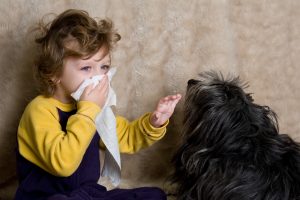The Allergic Dilemma: Best Pets For Pet Allergy Sufferers

An estimated 15% of people have a pet allergy, with cats being the most common perpetrators, followed closely by dogs. Fortunately, having a pet allergy doesn’t necessarily mean you can’t have a pet!
With a little bit of research and planning, many allergic pet owners have successfully intertwined their lives with a four-legged friend.
Understanding Your Pet Allergy
Dander, tiny flecks of skin shed by dogs, cats, rodents, and birds, is the most common pet allergy trigger. Other pet-related particles, including saliva, urine, and feces, can release particles into the air when dried, which can be inhaled and trigger allergic symptoms.
The symptoms of pet allergies include:
- Itchy, watery eyes
- Coughing
- Sneezing
- Stuffy nose
- Hives/rash
- Wheezing, asthma symptoms
Oftentimes, hay fever or asthma sufferers may find that their symptoms worsen in the presence of pets. It’s important to have your doctor diagnose your allergy so you can take the proper steps toward staying as comfortable as possible.
Dealing With Your Pet Allergies
The common advice for pet allergy sufferers is to simply not live with a pet. But for many of us, not sharing our lives with an animal or getting rid of a beloved pet is simply not an option. Try the following tactics to keep dander under control and reduce your symptoms:
- Clean your home frequently to remove dust and dander. Fabrics that your pet comes in contact with should be vacuumed or laundered frequently. This includes pillows, upholstered furniture, furniture covers, curtains, pet beds, and area rugs.
- Keep pets off of your furniture, throws and blankets.
- Don’t allow pets in your bedroom.
- Use HEPA air cleaners throughout your home.
- Bathe your pet weekly to reduce dander, including cats (with a cat-safe shampoo only). Consider professional grooming at our facility, as it will keep hair and other allergens that are stirred up in the grooming process out of your home. Give us a call for recommendations on products and bathing strategies.
- Replace carpets with tile or wood flooring, and remove or replace other allergy-trapping surfaces such as cloth drapes and table cloths.
- Talk with your allergist about treatments, which may include over-the-counter antihistamines, nasal sprays, or allergy shots.
Finding The Right Pet For You
Despite many claims, there are no truly hypoallergenic pets. However, some pets do shed less dander than others, such as:
- Kerry blue terriers – These dogs are energetic and make good family pets, although generally don’t do well with cats. Kerry blue terriers need plenty of exercise and mental stimulation in order to stay happy and well behaved.
- Hairless dogs – These are dogs that have no hair or very little hair, which greatly reduces dander. Included in this category are the American Hairless Terrier, the Mexican Hairless Dog, and the Chinese Crested Hairless.
- Hairless Sphynx cats –Hairless cats still produce dander, although due to having no hair it’s possible that the dander isn’t spread as far as with cats that shed fur. Severe cat allergy sufferers should stay away from all cats since the dried saliva and urine can cause allergic reactions.
- Standard Poodles – Because the poodle’s fur is tightly coiled and lacks an undercoat, there is typically less shedding, thus less dander floating into the air. The poodle’s luxurious, curly coats are prone to tangles and mats, and generally require professional grooming.
- Schnauzers – If kept groomed and clean, they shed far less than other breeds. Of the three sizes, Miniature Schnauzers are generally the easiest to care for as they are small and known for not shedding fur. Small breeds, in general, that are bathed and brushed frequently, and kept well-groomed, tend to shed less fur and dander than larger breeds.
- Rodents – Hamsters, mice, rats, gerbils, and guinea pigs all produce dander, but because they are generally confined to smaller living quarters it’s easier to keep the allergens contained to their cage with regular cleaning. Keep in mind that many rodents, such as hamsters, are nocturnal and do most of their activities at night, so if you have light sleepers in the house, this may not be the pet for you.
- Reptiles and amphibians – Because they are not “warm blooded”, reptiles and amphibians don’t produce dander and can therefore be good candidates for an allergy sufferer’s pet. These are exotic pets with specific requirements for their environment, nutrition, and medical care, so do your research and be prepared before committing to one of these beautiful creatures.
Your team at Lone Tree Veterinary Medical Center is committed to helping you enjoy your life with your pets! Don’t hesitate to give us a call with any questions or concerns regarding your pet.



